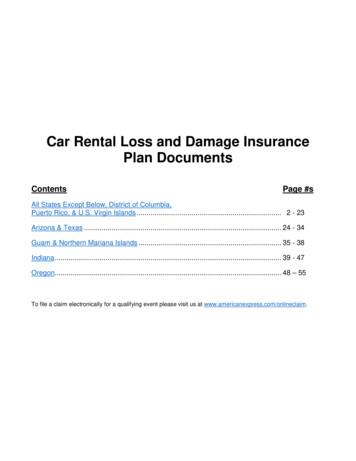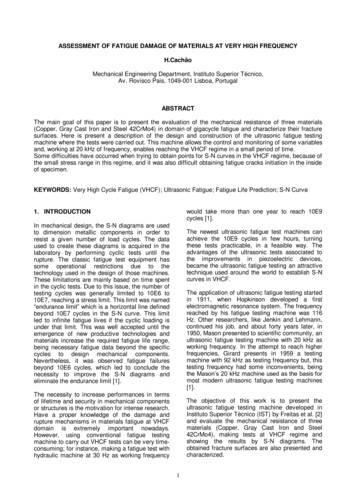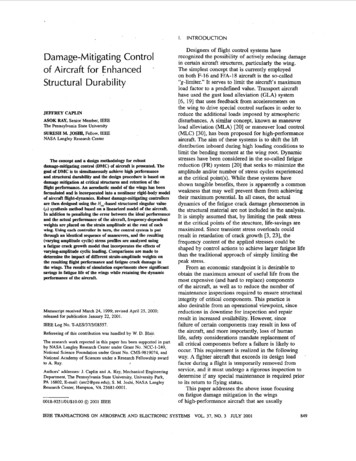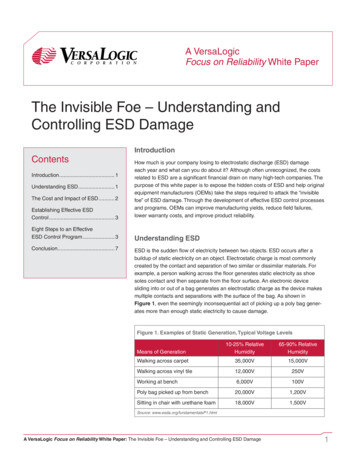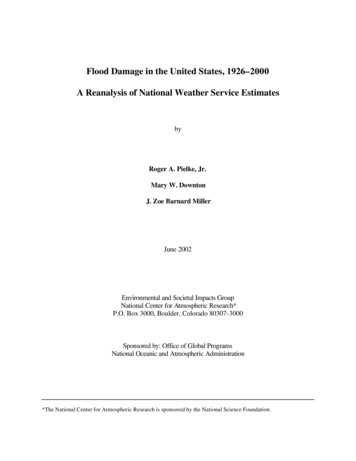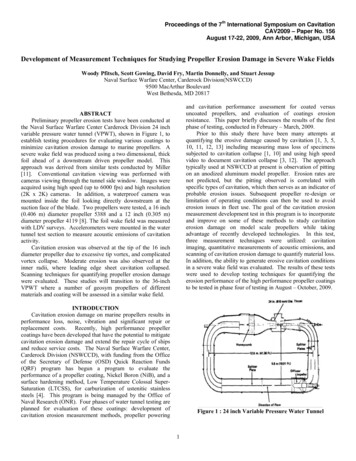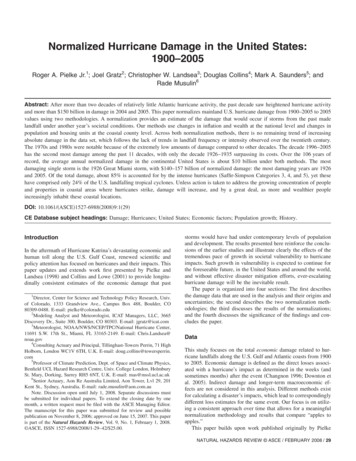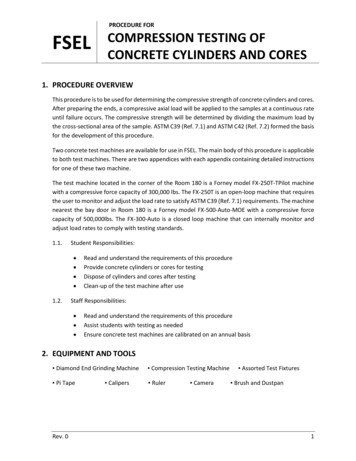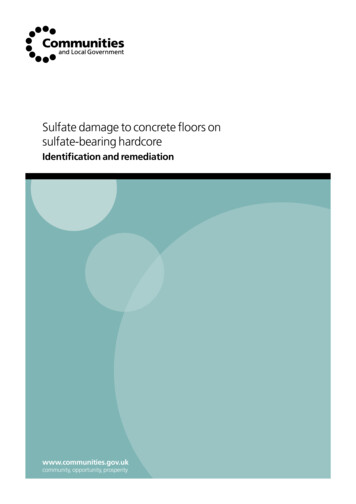
Transcription
Sulfate damage to concrete floors onsulfate-bearing hardcoreIdentification and remediationwww.communities.gov.ukcommunity, opportunity, prosperity
Sulfate damage to concrete floors onsulfate-bearing hardcoreIdentification and remediationThis document has been prepared by the Building ResearchEstablishment, any views expressed are not necessarily those of theDepartment for Communities and Local GovernmentIan Longworth, MSc(Eng), CGeol, CSci,BRE Associate, Materials and Engineering Group,Building Research EstablishmentFebruary 2008Department for Communities and Local Government
Copyright in the contents, the cover, the design and the typographical arrangement rests with the Crown.This document/publication is value added. If you wish to re-use this material, please apply for a Click-UseLicence for value added material at Alternatively applications can be sent to:OPSI, Information Policy Team,St Clements House,2-16 Colegate,Norwich NR3 1BQFax: 01603 723000E-mail: HMSOlicensing@cabinet-office.x.gsi.gov.ukThis publication has been approved by Ministers and has official status. The contents of this publication may bereproduced free of charge in any format or medium for the purposes of private research and study or for internalcirculation within an organisation. This is subject to the contents being reproduced accurately and not in a way thatimplies official status. Any publisher wishing to reproduce the content of this publication must not use or replicatethe HMG logo or replicate the official version’s style and appearance, including the design, and must not presenttheir publication as being an official publication as this may confuse the public. The reproduced material must beacknowledged as Crown Copyright and the title of the publication specified. HM Government does not accept anyresponsibility for the accuracy and the comprehensiveness of any other versions.Any other use of the contents of this publication would require a copyright licence. Further information can obtainedfrom www.opsi.gov.ukISBN-13 978 1 85946 301 7Further copies are available from:RIBA Publishing15 Bonhill StreetLondonEC2P 2EATel: 020 7256 7222Fax: 020 7374 2737Email: sales@ribabookshops.comWebsite: www.ribabookshops.com Crown Copyright 2006.Printed on material containing 100% post-consumer waste (text),75% post-consumer waste and 25% ECF pulp (cover).75%February 2008Product Code: 07BD05094
Executive Summary 3Executive SummaryThis document gives guidance on sulfate-attack damage to houses from the past use ofsulfate-bearing hardcore and infill material.Background to the guidanceSulfate-bearing hardcore, derived from colliery spoil and other industrial by-products,was included in the construction of hundred of thousands of domestic properties in theperiod 1945 – 1970 as support for concrete floor slabs. The legacy has been a continuingoccurrence of damage to floor slabs and abutting walls as sulfate from the hardcorehas attacked the overlying concrete. Remediation of such damage is rarely covered byhousehold insurance, as the cause is deemed to be a latent construction defect. Thus, inmost cases, owner-occupiers have had to pay (typically 10-20k) out of their own pocketsfor repair. The situation has promoted a blight of numerous housing estates where caseshave occurred, since prospective buyers and professionals concerned with house purchaseand mortgages have naturally been very cautious when dealing with properties thatmay have sulfate attack. In some cases the only way to remove such blight has been theexpenditure of government funds to remediate properties en masse.The overall aim of this project is to provide authoritative guidance to local authorities,professionals and homeowners who are concerned with damage to houses and otherdwellings caused by sulfate attack to floor slabs resulting from past use of sulfate-bearinghardcore.Preparation of this document has required discussions with numerous professionals whoare stakeholders in problems arising from sulfate-bearing hardcore. Their views havebeen diverse and sometimes times conflicting, typically reflecting differences in practiceaccording to regional location. As a consequence, to be nationally acceptable, theguidance necessarily includes several options for procedures for investigation, assessmentand remedial measures. As clearly stated, in the introduction to this document, it remainsthe responsibility of the professionals involved with a particular property to decide whichof the options to utilise. Their actions will rightly be based on local experience and housingmarket constraints. Each dwelling will need to be considered on its own merits.
4 Sulfate damage to concrete floors on sulfate-bearing hardcoreOutline of the guidance documentSections 1 to 5 provide information on the mechanism of sulfate attack and where it ismost likely to be found. Key points made are: For deleterious sulfate attack to occur in a ground floor slab, the concrete must be ofa type susceptible to sulfate attack and it must be in direct contact with hardcore thatcontains a substantial amount of sulfates and moisture. No deleterious level of sulfateattack has been found where an intervening damp-proof membrane separates theconcrete from the hardcore. Domestic buildings constructed from the early 1970s onwards are unlikely to haveconcrete floor slabs that will be affected by sulfate attack owing to a generalrecognition of problems arising from sulfate-bearing fills and adoption of appropriatedesign and construction measures.Sections 6 to 8 provide information on the diagnostic procedures of sulfate attack and theassessment of the potential for further damage. Guidance is given on: The mechanism of damage, including how expansion of the sulfate-attacked concretecauses doming of the floor slab and pushes out walls below DPC. How to confirm the cause of damage by laboratory examination of concrete andhardcore. What factors to take into account when assessing risk – the likelihood of a furtherdevelopment of sulfate attack, compounded by the seriousness of the consequences.Section 9 discusses the options for carrying out remedial works following sulfate attack,including the need to comply with recently introduced Building Regulations concerninginsulation of floors and the provision (in some areas) of measures to prevent ingress ofradon gas.Section 10 outlines the environmentally correct procedures for disposal of wastes resultingfrom removal of hardcore and sulfate-attacked concrete.
Contents 5Contents1.Introduction 62.What are sulfates and sulfate attack? 73.Factors that contribute to deleterious sulfate attack 104.Historical perspective 155.Regions where sulfate-bearing hardcore was utilised 196.How to recognise typical damage from sulfate attack 207.Procedure for confirming the cause of damage to be sulfate attack 248.Assessing the potential for further damage 289.Repairs following sulfate attack 2910. Disposal of removed hardcore and sulfate-affected concrete 3411. References 36
6 Sulfate damage to concrete floors on sulfate-bearing hardcore1. IntroductionThis guidance deals with damage to houses caused by sulfate attack to concrete floor slabsand oversite concrete that are placed directly on hardcore (fill) containing reactive sulfates.Sulfate-bearing hardcore, derived from colliery spoil and other industrial by-products,was included in the construction of many thousands of domestic properties in the period1945–1970, as support for concrete floor slabs, without the use of a separating dampproof membrane. The legacy has been a continuing occurrence of damage to floor slabsand abutting walls as sulfate from the hardcore has reacted with the overlying concreteresulting in cracking, expansion and deformation. Figure 1 shows typical damage to a floorslab in a house built in the 1950s.The aim of this guidance is to provide an understanding of the problem and to recommenda toolkit of techniques which professionals dealing with affected houses can use toidentify sulfate attack and deal with any consequent problems or damage. It remains theresponsibility of the professionals involved with each particular property to decide which ofthese techniques to utilise, to prioritise the criteria for assessment of current and possiblefuture damage, and to decide which remedial measures to employ, if indeed any. Theiractions will be based necessarily on local experience and housing market constraints.This guidance does not cover the expansion of hardcore and consequent building damageresulting from the self-expansion of metaliferous slags[1] or of geological materialscontaining the potentially reactive mineral pyrite.[2] Both of these problems are (briefly)dealt with in BRE Digest 276: Hardcore.[3]Figure 1: Distortion and cracking of a concrete floor slab causedby sulfate attack. Damage is greatest in front of the fireplace wherewater, carrying sulfates from underlying hardcore, has been drawnthrough the slab by heat from the fire.
2. What are sulfates and sulfate attack? 72. What are sulfates and sulfate attack?Sulfates are salts in which the negatively charged ion (anion) SO42– forms a compoundwith a metal positively charged ion (cation) such as Ca2 . In hardcore we are concernedprimarily with sulfates that are readily soluble in water and which can therefore be readilytransported to react with concrete. Such sulfates include gypsum (calcium sulfate, CaSO4),epsomite (magnesium sulfate, MgSO4), and Glauber’s salt (sodium sulfate, Na2SO4).Sulfate-bearing materials which have been used in the past as hardcore in domesticproperties include burnt colliery spoil (red ash or red shale), furnace bottom ash (black ash),blastfurnace slag, oxidised pyritic shales, and demolition debris containing gypsum plaster.Geographical occurrence of these materials is discussed in Section 5.The amount of soluble sulfates present in the material is a vital factor in determiningthe potential for sulfate attack on concrete. Unfortunately, it may be difficult to getrepresentative values of soluble sulfates in some materials because of their inherentvariability. A suggested procedure for existing hardcore is detailed in Section 7.Where a concrete slab overlies moist sulfate-bearing hardcore without an effectiveintervening waterproof membrane, the sulfates in hardcore may migrate into the concretewhere they react with constituents in the cement matrix. Two sulfate attack mechanismshave been identified as affecting concrete slabs and oversite concrete:Box 1: What is hardcore?Hardcore is fill material used in building construction to raise ground levels and provide a dry,firm and level base on which to cast a concrete ground floor slab or ‘oversite’ concrete beneathsuspended floors. To avoid subsequent problems, materials for hardcore should be granular,free-draining and consolidate readily. The hardcore should be well-compacted in layers ofappropriate thickness. Materials should also be chemically inert and not physically affected bywater. Unfortunately, some of the materials and placing procedures used in the past have notmet these requirements and there has been consequent damage to buildings. The principalproblems have been chemical attack by hardcore materials on concrete, settlement due to poorcompaction, and swelling or consolidation resulting from changes in moisture content and/orchemical instability. An overview of hardcore is given in BRE Digest 276:1992.[3](i) Conventional or ettringite form of sulfate attackIn this type of attack, sulfates and water react with the tricalcium aluminate found inPortland cement to form a calcium sulfo-aluminate hydrate (3CaO.Al2O3.3CaSO4.31H2O)known as ettringite. This type of sulfate reaction has long been known and most publishedguidance on sulfate attack has addressed this mode. The formation of ettringite can bedestructively expansive since it has a solid volume greater than the original constituents andtypically grows as myriad acicular (needle-shaped) crystals that can collectively generatehigh internal stresses in the concrete.
8 Sulfate damage to concrete floors on sulfate-bearing hardcoreTo produce deleterious amounts of ettringite the reaction requires the presence of: a significant concentration of water-soluble sulfates concrete which contains a substantial content of calcium aluminate hydrates, as is thecase in concrete made with most Portland cements wet conditions.Incoming sulfate ions may also react with calcium hydroxide Ca(OH)2 in the cementmatrix of concrete to form gypsum (calcium sulfate dihydrate, CaSO4.2H2O). This reactionproduct also has a greater solid volume than the original constituents and in some casescan contribute to degradation of the concrete. If magnesium ions accompany the sulfates,they may also react with calcium hydroxide, producing brucite (magnesium hydroxide,Mg(OH)2) which because of its low solubility precipitates out of solution, also leading toan increase in solid volume. Magnesium ions may also attack calcium silicate hydrates,the principal bonding material in set concrete.Laboratory tests show that the first effect of the conventional form of sulfate attack isto increase the strength and density of the concrete as the reaction products fill the porespace. When it is filled, further ettringite formation induces expansive internal stresses inthe concrete which, if greater than the tensile strength of the concrete, will expansivelydisrupt the affected region. This cracking together with white crystalline accumulationsare the characteristic signs of the conventional form of sulfate attack.(ii) The thaumasite form of sulfate attack (TSA)This form of sulfate attack was first recognised in the UK in the 1990s and has sincebeen found in several floor slabs and in oversite concrete. The reaction product isthe mineral thaumasite which is a calcium silicate carbonate sulfate hydrate,(CaSiO3.CaCO3.CaSO4.15H2O).Deleterious levels of TSA require the following: a significant concentration of water-soluble sulfates concrete which contains calcium silicate hydrates, as mostly derived from cementitiouscalcium silicate phases in Portland cements a source of carbonate, generally from a limestone aggregate a pH of 10 or higher, such as found in non-carbonated concrete persistent wetness low temperature (generally below 15 C).
2. What are sulfates and sulfate attack? 9Since the calcium silicate hydrates provide the main binding agent in Portland cement, thisform of attack weakens the concrete as well as causing some expansion and, in advancedcases, the cement paste matrix is eventually reduced to a mushy, incohesive mass.Further details of the chemistry of sulfate attack and factors contributing to its occurrencemay be found in BRE Special Digest 1 SD1:1965).[4]
10 Sulfate damage to concrete floors on sulfate-bearing hardcore3. Factors that contribute to deleterioussulfate attackThe principal chemical factors required for sulfate attack identified in Section 2 arediscussed here in terms of the likelihood of their occurrence. Additionally, othercontributing factors are discussed which play a significant role in determining the likelihoodof sulfate attack and its severity.Factors inherent in hardcore The types of sulfate in hardcore are important. For sulfate attack to occur in floor slabs,sulfates must be carried into the concrete by interstitial water. Four sulfate compoundsare both water-soluble and common in geological materials, namely: calcium sulfate,magnesium sulfate, sodium sulfate and potassium sulfate. Calcium sulfate is the mostprevalent, but the least soluble (giving a maximum dissolved concentration of about1400 mg SO4 per litre of water) and because of that it is the least harmful to concrete.The other sulfates are much more soluble and potentially harmful to concrete sincethey can approach the concrete in large concentrations. Of these, magnesium sulfatecan be particularly harmful as the magnesium cations from this can themselvescontribute to destruction of concrete.The respective contributions of the four sulfate compounds are taken into account inthe 2:1 water/solids extract test for sulfates[4] which caps the amount of calcium sulfateextracted, whilst allowing full extraction of the other more soluble sulfates. The total amount of sulfates in the hardcore is a significant factor. This depends on theconcentration of sulfates in a unit volume of hardcore and the overall thickness of thehardcore. If a large reservoir of sulfates is present sulfate attack can be progressive overmany years as sulfate in water in contact with the concrete is replenished. The acidsoluble sulfate test for fill materials addresses this factor.[4] The degree to which the sulfates are bound within the hardcore material is relevant.In some materials, such as blastfurnace slag, a substantial proportion of the sulfatemay be locked in fused granules and be inaccessible for solution by interstitial water.In other materials, such as burnt colliery spoil, it is more readily soluble. The general inhomogeneity of hardcore derived from waste materials is a factor tobe borne in mind when investigating it for sulfates. Sulfate contents can be expectedto have varied substantially in the originally deposited hardcore and may have beenchanged subsequently by flow of interstitial water through the hardcore.Figures 2 and 3 show sulfate contents measured by the Building Research Establishment(BRE) in burnt colliery spoil (red shale) hardcore sampled at depths below a concretefloor slab in two rooms (kitchen and lounge) of a house in Stoke on Trent. Total amounts
3. Factors that contribute to deleterious sulfate attack 11of sulfate in the material, as determined by acid extraction (Figure 2) on handful sizedsamples, vary erratically from 1.3 to 2.25 per cent SO4, reflecting the original variabilityof the hardcore . In contrast, water-soluble sulfates by 2:1 water/solids extraction onthe same samples (Figure 3) show profiles with depth that have undoubtedly beeninfluenced by upward passage of water through the hardcore. This extract test isweighted in favour of the more soluble sulfates (those of magnesium, sodium andpotassium which are potentially more harmful to concrete) and it is evident that thesehave been drawn upwards so that concentration increases with proximity to theconcrete slab. Moreover the two rooms give substantially different results, presumablyreflecting different water migration regimes. The lower values in the kitchen area (andparticularly the topmost result measured just below the overlying concrete slab) mayalso indicate that here there has been a depletion owing to migration of sulfates intothe overlying concrete.Overall, the variability of results (some 70%), demonstrates the inappropriateness ofevaluating the potential for future sulfate attack using just one or two test results on ahouse as the sole criterion.The presence of a substantial proportion of fines in the hardcore will promote upwardflow of sulfate-bearing water by capillary action. The presence in some types of hardcore of pyrite (iron disulfide) that can oxidise as aresult of exposure to air, water and bacteria, leading to the formation of additionalsulfates.[4] Hardcore of this category includes incompletely or unburnt coal mine spoiland some quarried rocks such as the Cleveland Ironstone formation.Depth below top of slab: m Figure 2: Acid-soluble sulfate contents in burnt colliery spoil (red shale) sampled at depths below a concrete floor slabin a 40 year old house. The values, which represent the total amount of sulfates present in the hardcore, vary erraticallywith depth from 1.3 to 2.25 per cent SO4, reflecting the original variability of the hardcore.
Depth below top of slab: m12 Sulfate damage to concrete floors on sulfate-bearing hardcoreFigure 3: Water-soluble sulfate contents in burnt colliery spoil (red shale) sampled
4 Sulfate damage to concrete floors on sulfate-bearing hardcore Outline of the guidance document Sections 1 to 5 provide information on the mechanism of sulfate attack and where it is most likely to be found. K


